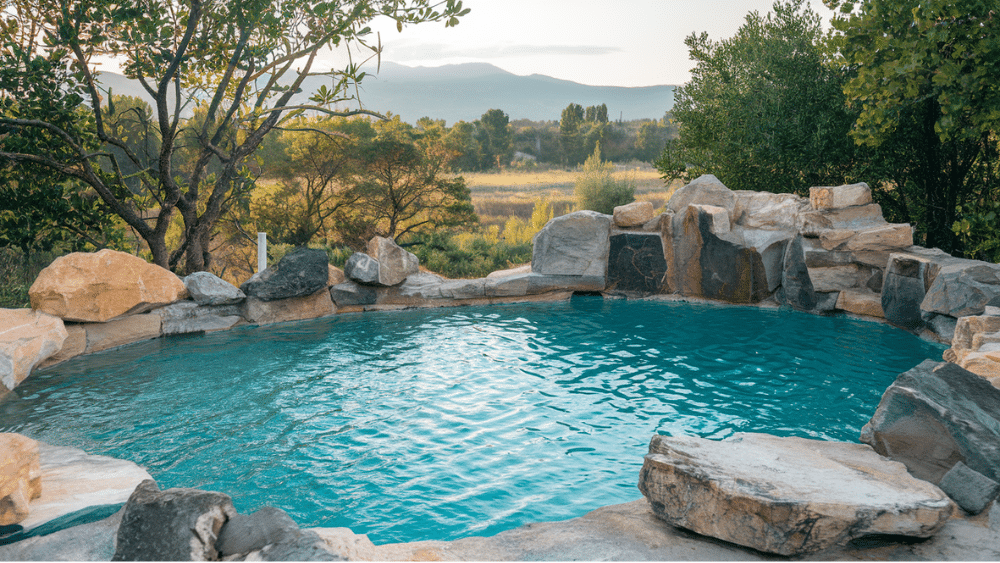Here’s the thing: the right rocks can completely change your pool’s appearance and turn your backyard into a stunning retreat.
From smooth river stones to dramatic boulders, choosing the correct stone materials makes all the difference between an ordinary pool and an extraordinary outdoor space.
But which rocks work best? How do you pick materials that won’t crack, fade, or become slippery when wet? What about maintenance and cost?
In this guide, you’ll learn about the top rock options for pool areas, including practical tips for installation, safety considerations, and design ideas that will make your neighbors stop and stare.
Ready to create the pool oasis you’ve always wanted? Let’s study your best stone options.
Things to Consider Before Choosing Rocks
Before you start shopping for rocks, take a moment to assess your specific situation. Your pool type matters significantly – in-ground pools with existing pavers need different stone solutions than above-ground pools with wooden decks.
Consider your local climate too. Some stones absorb and hold heat, making them uncomfortable for bare feet during summer. Others crack when the temperature drops below freezing.
Think about how your family uses the pool area:
- High foot traffic areas need slip-resistant stones with smooth, comfortable surfaces
- Families with children should prioritize rounded edges and non-slip textures
- Barefoot zones require stones that stay cool and won’t cause cuts or scrapes
Your budget plays a significant role in your final decision. Bare gravel costs much less than premium flagstone, but factor in installation expenses. Some rocks need professional grading or special edging to stay in place. Others can be installed yourself over a weekend.
Take time to evaluate these factors now. The right choice depends on matching stone characteristics to your specific needs, not just selecting what looks visually appealing in photos.
Types of Rocks to Use Around Pools
The right rock choice changes your pool area from basic to beautiful while solving practical problems like drainage and safety.
1. River Rocks
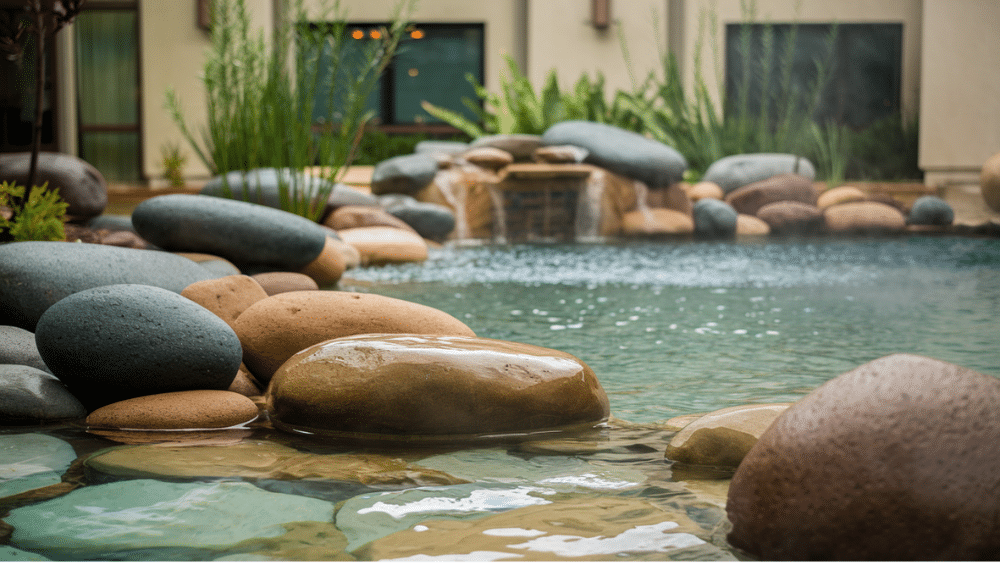
River rocks offer the perfect blend of beauty and safety for pool areas. These naturally tumbled stones create a spa-like atmosphere while providing excellent water drainage. Their smooth surfaces make them ideal for areas where people frequently walk barefoot.
- Smooth, rounded edges prevent cuts and scrapes on bare feet
- Natural earth tones (gray, brown, tan) complement any landscape design
- Superior drainage prevents water pooling and reduces slip hazards
Unique advantage: River rocks naturally interlock, creating a stable surface that won’t shift easily under foot traffic.
2. Pea Gravel
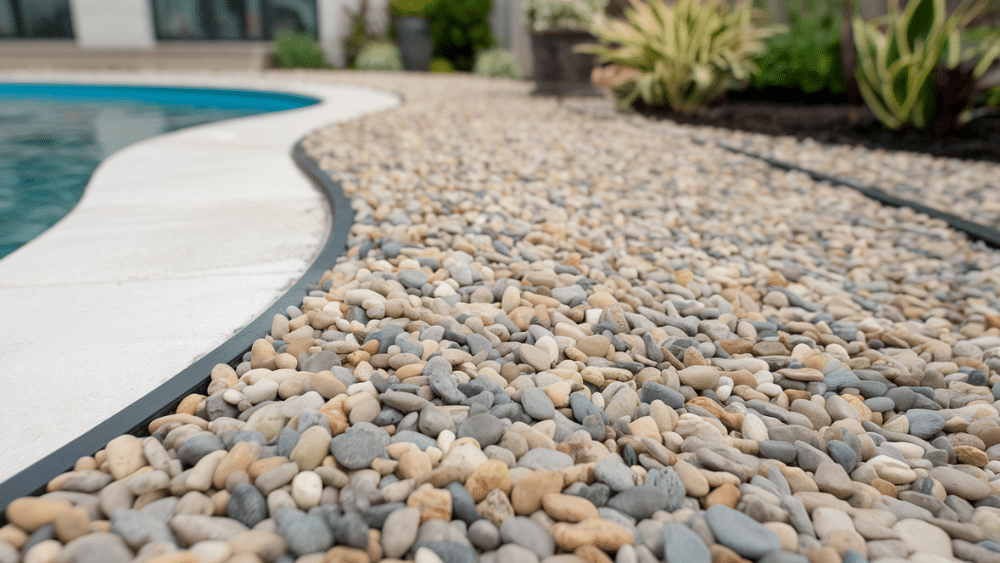
Pea gravel delivers big style on a small budget. These tiny, uniform stones work well in both formal and casual pool settings. Installation is simple enough for most DIY homeowners to handle over a weekend.
- Small size (¼ inch) makes them comfortable underfoot
- Most affordable rock option for large coverage areas
- Available in multiple colors to match your design scheme
Unique advantage: Pea gravel conforms to any shape or curve, making it perfect for irregular pool areas where larger stones won’t fit.
3. Lava Rocks
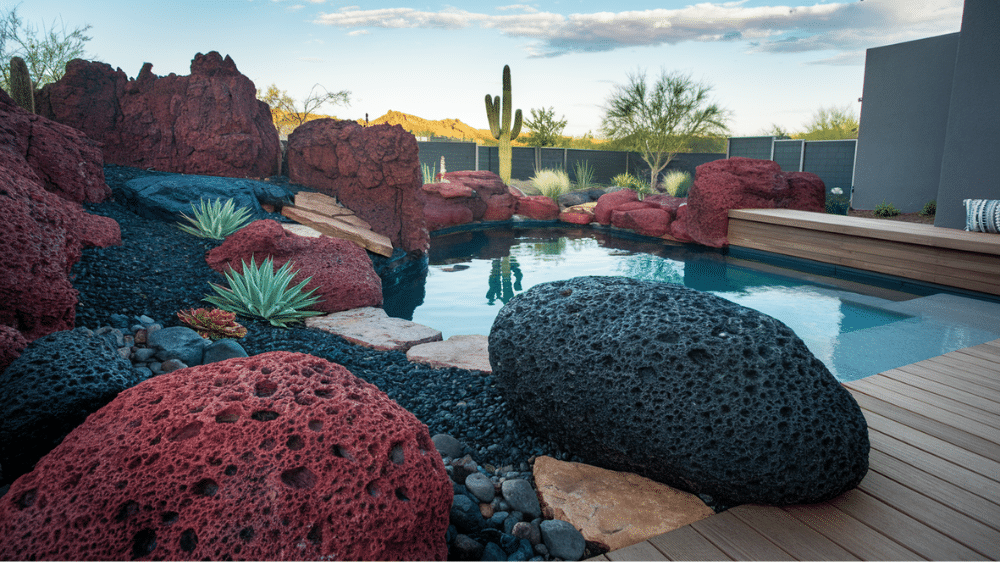
Lava rocks bring bold visual impact to modern pool designs. Their unique porous texture provides excellent drainage while their dramatic colors create striking contrasts. These lightweight stones are surprisingly easy to move and arrange during installation.
- Porous structure allows superior water drainage and airflow
- Distinctive red, black, or charcoal colors make dramatic design statements
- Lightweight nature reduces shipping costs and installation effort
Unique advantage: Lava rocks naturally regulate temperature, staying cooler in summer heat than dense stone alternatives.
4. Crushed Granite or Decomposed Granite
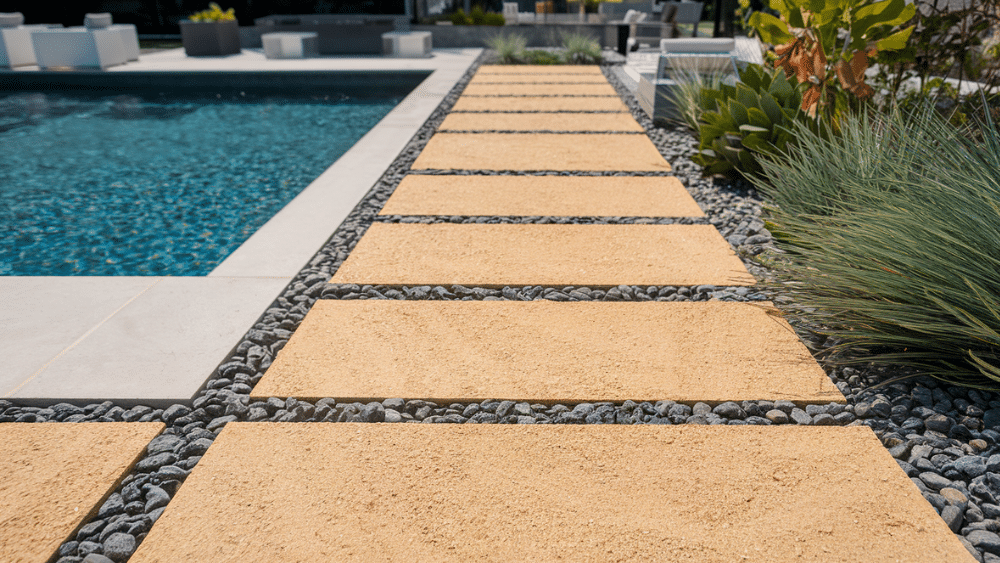
Crushed granite provides a refined, natural appearance that complements contemporary pool designs beautifully. This material compacts well to create stable walking surfaces. Professional installation is recommended for best results and longevity.
- Fine texture creates smooth, comfortable walking surfaces
- Excellent drainage prevents standing water issues
- Natural granite colors blend seamlessly with outdoor environments
Unique advantage: When properly installed and compacted, crushed granite forms an almost concrete-like surface that still looks completely natural.
5. Flagstone or Slate Chips
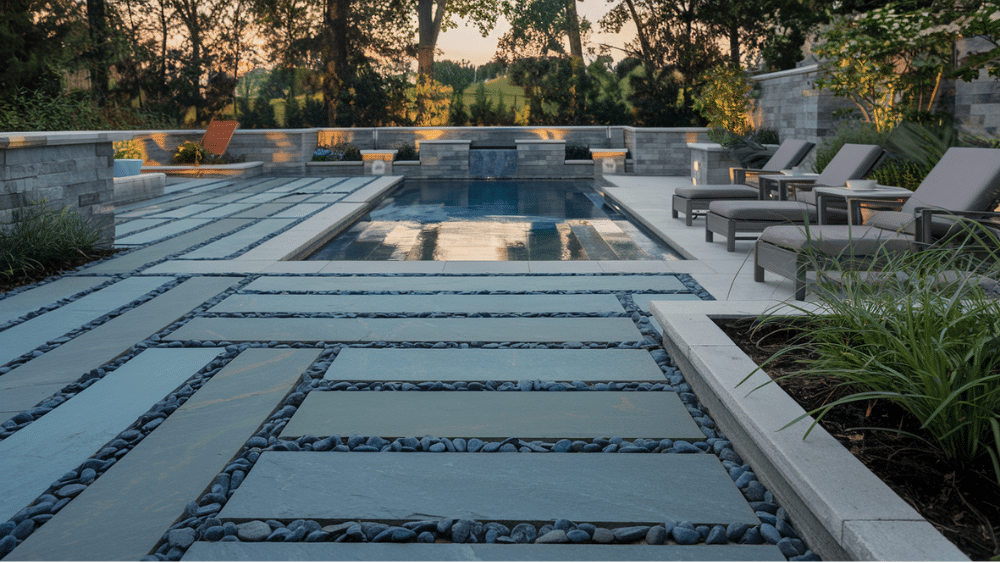
Flagstone and slate chips provide an upscale, elegant appearance perfect for luxury pool areas. These flat stones create clean lines and sophisticated color palettes. Choose textured varieties to maintain safety around wet areas.
- Flat surfaces create clean, geometric design elements
- Premium appearance increases property value and visual appeal
- Available in various sizes from small chips to large stepping stones
Unique advantage: Flagstone and slate naturally split along flat planes, creating consistent thickness that’s perfect for level walking surfaces.
Benefits of Using Rocks Around Your Pool
1. Aesthetic Appeal: Rocks create a natural, spa-like atmosphere that blends seamlessly with your landscape, offering endless customization options through various colors, textures, and sizes to match your design vision.
2. Low Maintenance: Unlike grass that needs mowing or mulch that decomposes yearly, rocks provide a permanent solution that requires only occasional rinsing and minimal upkeep over many years.
3. Superior Drainage: The spaces between rocks allow water to flow through quickly, preventing muddy areas and standing water that can create slip hazards or attract mosquitoes around your pool.
4. Natural Weed Control: A proper rock installation with landscape fabric underneath blocks sunlight and creates an environment where weeds struggle to grow, reducing your yard work significantly.
5. Temperature Regulation: Many rock types stay cooler than concrete or pavers in direct sunlight, making them more comfortable for bare feet during hot summer days when pool areas see the most use.
Cost & Installation
Understanding costs upfront helps you make smart decisions that fit your budget and skill level.
| Rock Type | Cost per Cubic Yard | Cost per Ton | DIY Difficulty | Professional Install Cost |
|---|---|---|---|---|
| River Rocks | $33–$160 | $50–$100 | Easy | $200–$400 |
| Pea Gravel | $15–$75 | $28–$60 | Very Easy | $150–$300 |
| Lava Rocks | $75–$140 | $76–$150 | Moderate | $300–$500 |
| Crushed Granite | $25–$70 | $25–$85 | Moderate | $250–$450 |
| Flagstone Chips | $80–$150 | $100–$200 | Hard | $400–$700 |
- DIY vs. Professional Installation: Most homeowners can handle pea gravel and river rock installations with basic tools and weekend effort. Crushed granite requires compacting equipment, whereas flagstone often requires professional leveling for optimal results.
- Local Sourcing Tips: Check quarries, landscape supply yards, and construction material dealers in your area. Local sources typically offer better prices and can deliver bulk orders. Ask about seasonal sales – many suppliers offer discounts on materials during off-peak months.
- Smart shopping saves money while ensuring quality results. Get quotes from multiple suppliers and factor in delivery costs when comparing prices.
5 Safety Considerations When Using Rocks Around Your Pool
1. Non-Slip Surface Selection: Choose rocks with textured or rough surfaces near pool edges and walkways, avoiding smooth stones that become slippery when wet and can cause dangerous falls.
2. Proper Rock Containment: Install sturdy edging materials like metal strips or concrete borders to prevent rocks from shifting into the pool or creating trip hazards on walkways.
3. Sharp Edge Prevention: Avoid jagged stones like broken concrete or freshly crushed rock that can cut bare feet, especially in areas where children play or people walk without shoes.
4. Heat Absorption Management: Test dark-colored rocks during hot weather before installation, as black lava rock and dark granite can become too hot to walk on comfortably during peak summer temperatures.
5. Adequate Drainage Planning: Ensure rocks don’t create water dams or redirect drainage toward your pool equipment, foundation, or neighboring properties, which can cause expensive damage over time.
How to Maintain Rocks Around Your Pool
- Regular Debris Removal: Use a leaf blower or rake weekly during fall months to clear leaves, twigs, and other organic matter that can decompose and create staining or unpleasant odors around your pool area.
- Weed Prevention and Control: Apply pre-emergent herbicide twice yearly and spot-treat any weeds that break through with targeted treatments, avoiding broad-spectrum chemicals that could harm nearby plants or pool water.
- Rock Refresh Schedule: Add fresh rocks every 2-3 years to replace stones that have shifted, broken down, or become discolored, maintaining both the appearance and functionality of your pool landscaping.
- Seasonal Deep Cleaning: Rinse rocks thoroughly with a garden hose each spring to remove winter debris, salt residue, and accumulated dirt that can dull their natural colors and clog drainage spaces.
- Edge Maintenance: Check and repair containment edging annually to prevent rock migration, ensuring your investment stays in place and continues looking neat and professional.
Conclusion
Choosing the right rocks for your pool area doesn’t have to be complicated. River rocks offer safety and natural beauty, while pea gravel provides budget-friendly versatility. Lava rocks make bold statements, and crushed granite delivers refined elegance.
Remember the key factors: your climate, foot traffic patterns, and maintenance preferences. Proper installation with good drainage and containment ensures your investment remains in top condition for years.
Start by measuring your space and getting quotes from local suppliers. Many rock types are suitable for DIY installation, allowing you to save money while creating the outdoor space you desire.
Your pool area should reflect your style while staying safe and functional. With the right rock choice, you’ll have a beautiful, low-maintenance space that enhances every swim season.
What rock type matches your vision? Start planning your pool transformation today and enjoy the results for years to come.

